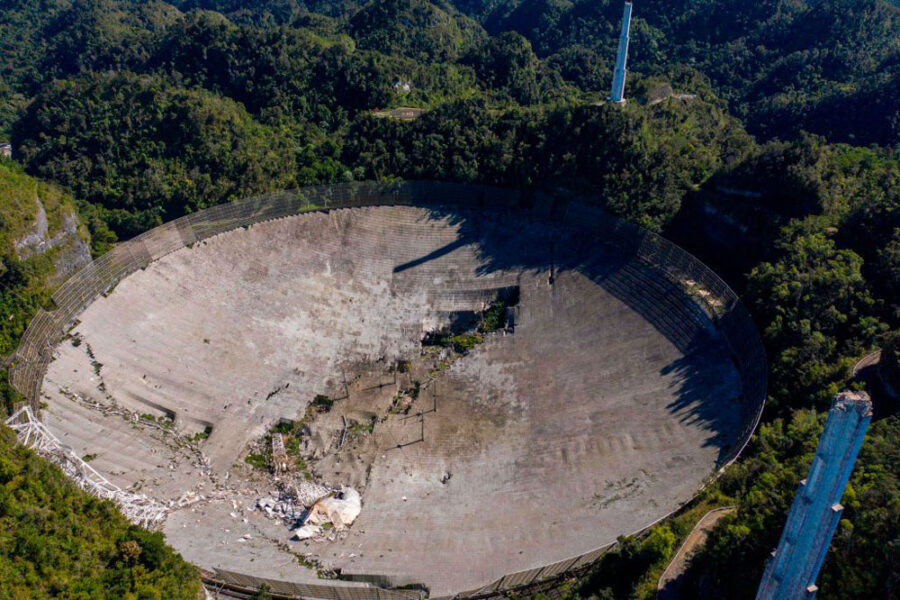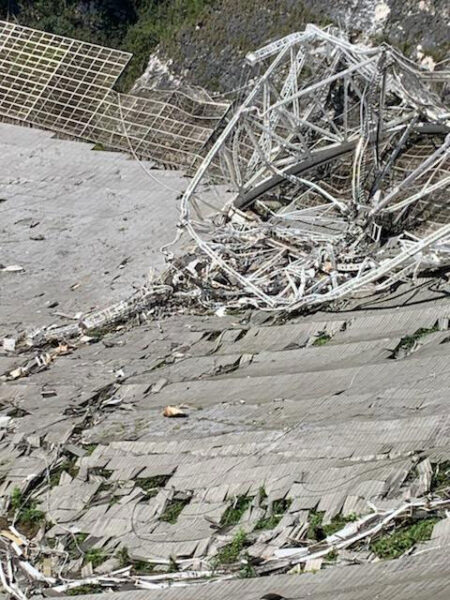The Arecibo telescope in Puerto Rico has collapsed less than two weeks after officials announced it was too dangerous to attempt repairs.
Updates:
The National Science Foundation has released footage of the telescope's collapse. Find more information on the video footage on the NSF website.
Astronomers knew the clock was ticking for the iconic Arecibo radio telescope in Puerto Rico. Engineers had pronounced the second-largest radio dish in the world to be on the brink of collapse and too dangerous to try to repair.
At 7:55 a.m. local time on December 1st, that ticking clock struck midnight. The National Science Foundation is reporting that the 900-ton platform, suspended over the dish via multiple cables to three support towers, has fallen.

Photo by Ricardo Arduengo / AFP via Getty Images
It crashed into the dish and damaged surrounding facilities, ending any hopes of a more controlled decommissioning. No injuries were reported as a result of the collapse.

UCF
Staff member Jonathan Friedman, who lives near the telescope, reported to the Associated Press that he heard the collapse as a rumble. When he ran to a hill overlooking the natural sinkhole that’s home to the massive 305-meter radio dish, he could see the dust cloud coming up from the collapsed structure.
Twitter user Deborah Martorell shared a photo of the collapse from afar:
Amigos es con profundo pesar comunicarles que acaba de colapsar la plataforma del Observatorio de Arecibo. pic.twitter.com/stJScy2Old
— Deborah Martorell (@DeborahTiempo) December 1, 2020
The collapse follows two cable failures within four months. First, a support cable wrenched out of its socket on August 10th, then a main cable snapped on November 6th. Two weeks later, the NSF announced that it would dismantle the telescope, while still supporting other onsite facilities, such as the LIDAR facility for geospace research. While engineers had assessed the structure after the first cable failure and replacement parts were on order, the second failure suggested the system could collapse at any time. Each cable is 8.25 centimeters thick and made of 160 wires, but drone footage of the remaining cables to that tower showed individual wires were breaking daily.
A preliminary assessment of the collapse indicates that the top section of all three of the support towers broke off. Then as the platform fell, the support cables also dropped. The visitor's center, which is situated near Tower 12, managed to escape serious damage even though the top of the tower went tumbling down the hill nearby.
The platform that collapsed was original to the 1960s construction but became significantly heavier in the 1990s, when new instruments were added. That upgrade — including a Gregorian reflector system to help focus radio signals and a powerful radar transmitter — made Arecibo the powerhouse radio observatory and radar facility it was until this past August. The upgrade also warranted additional support cables, and it was one of these support cables that came out of its socket in August. “[It] should not have failed the way it did,” says Ashley Zauderer (NSF). "The team is looking very closely at why that happened."
“Our focus is now on assessing the damage, finding ways to restore operations at other parts of the observatory, and working to continue supporting the scientific community, and the people of Puerto Rico,” says NSF director Sethuraman Panchanathan. Engineers and environmental workers are already arriving at the site to appraise the situation and begin repairs to the other onsite facilities.
Read more about the impact of the observatory's loss on the astronomy community and on Puerto Rico: "Iconic Arecibo Telescope Damaged, To Be Dismantled."
 4
4









Comments
crk112
December 5, 2020 at 8:50 am
My goodness.. the Arecibo has been part of my memories for as long as I've been following astronomy ... 20+ years now with S&T! This is a sad ending, but thankfully they recognized the danger and were able to prevent injury. At the end it was coming apart so fast it happened while they were inspecting it with the drone!! Amazing footage!!
You must be logged in to post a comment.
Kevin-McElrath
December 5, 2020 at 5:43 pm
Arecibo was nicely featured in the movie "Contact",,, but the video of it coming down so closely resembles the loss of the machine that they were building in the same movie. What a loss to the community that used it and the surrounding economy.
You must be logged in to post a comment.
Jwandass3
December 5, 2020 at 5:47 pm
Years ago, my good friend and her husband visited Puerto Rico and saw the radio telescope. Knowing that I am an astronomy enthusiast, she brought back an Arecibo ballcap as a souvenir for me which I keep in my office to this day! Although I never saw the telescope in person, I am saddened by its loss and thankful that no one was injured.
You must be logged in to post a comment.
Anthony Barreiro
December 5, 2020 at 6:13 pm
Was it just a coincidence that the cables snapped while the top of the tower was being observed with a drone, or were the engineers watching the tower continuously by drone?
This is quite a catastrophe, and a very sad loss for science and Puerto Rico. Arecibo was almost 60 years old. That's a long time for a load-bearing steel structure to be exposed to tropical humidity, hurricanes, etc. The new dome installed in the 1990's was really heavy. I wonder if the recent funding problems, changes in ownership and management, etc., caused necessary maintenance to be deferred. I hope NSF will thoroughly investigate how this failure happened, and release a full public report.
Once we've figure out what went wrong, let's build it back better than before.
You must be logged in to post a comment.
You must be logged in to post a comment.